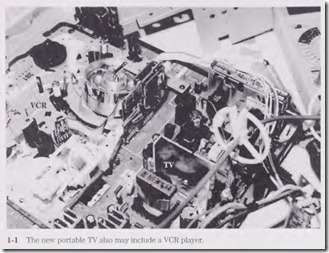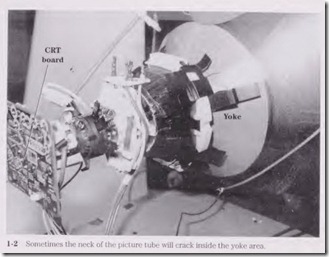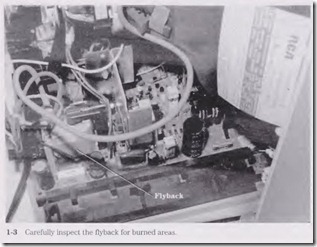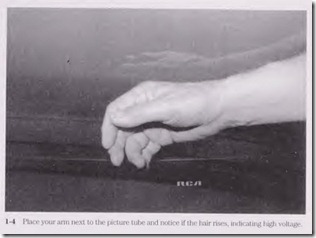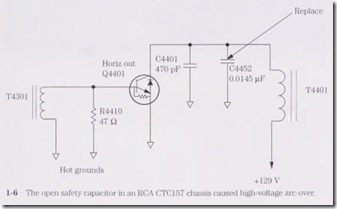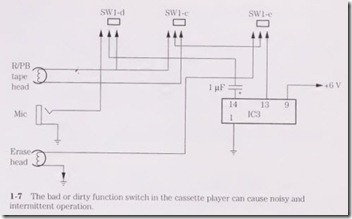Servicing methods without a schematic
Many different electronic products are found within the consumer electronics field. Yesterday, the radio was king, and today we have several new electronic products, such as the TVNCR combo, CD, DVD, DVDNCR combo, and MP3 players. After the early ra dio receiver, along came the phonograph player constructed inside a radio/phonograph combination. Later on, the cassette player was introduced within the portable radio/cassette player. Now the new TV chassis also might include a VCR and a DVD player (Fig. 1-1). Today, the new DVD player is combined with a DVD/CD, DVDNCR, or DVDNCRJCD changer, and on it goes.
Servicing consumer electronic products can be a lot of fun if you let it be. Just as in solving a great murder mystery, the smart detective must have the skill, desire, and ability to fmd the culpirt, so also the electronics technician must take the symptom and iso late, locate, remove, and replace the defective part.
The anticipation of locating a dead, open, or leaky component is like finding a needle in a haystack, so to speak. Your heart beats a little faster as you zoorn in on the sus pected part. Then great disappointment sets in when the suspected component is not the guilty party. So you try once again. Now victory is in sight.
Troubleshooting the TV chassis, VCR, CD/DVD player, and cassette player presents many rewards. Solving the intermittent or “tough dog” problem is a moment of triumph . However, if you can repair and service the electronic chassis without a schen1atic, you receive the highest honors of all. So let’s begin.
Locating critical components
Damaged components, burned printed circuit (PC) boards, and pulled PC wiring indi cate that the TV chassis has sustained lightning damage. Take a good look at the defec tive chassis. Visual inspection has repaired thousands of electronic chassis. Watch out for visual scars, such as a burned resistor, worn connections, arc-over parts, cracked boards, overheated components, and wear and tear.
For instance, firing or arcing inside the picture tube can indicate a cracked cathode-ray tube (CRT) gun assembly (Fig. 1-2). Arcing between parts on PC boards results from liquid spilled inside the chassis. Smoke curling up from overheated com ponents signals trouble ahead. When sweat forms on a carbon resistor, an overheated circuit is nearby.
Cracked or blown resistors or capacitors show signs of higher voltage or defective parts. Arcing inside the flyback transformer indicates leaky high-voltage diodes. Over heated white and dark marks on the integrated circuit (IC) body might point out a leak’Y part. Cracks found in ceramic capacitors and resistors indicate overheated compo nents. Too-hot-to-touch transistors or ICs might be leak? or shorted.
Several burned resistors might point to a leaky transistor or IC. Taking a close-up peek through a magnifying glass might solve the intermittent problem. Dark-brown areas around the component terminal leads on PC boards can indicate a poor con nection or overheated part. Just spend a little time before jumping to conclusions. Look before isolating, and then take another peek at the collected symptoms.
Just listen, man
Just listen and you can hear a defective component act up within the TV chassis. You should be able to hear the TV chassis with high voltage by listening with your ear close to the deflection yoke. Listen for arcing in the flyback or a tic-tic noise indicating hori zontal problems (Fig. 1-3). Intermittent arcing noise within a high-voltage capacitor can indicate an internal break or loose terminal wire.
Check the main filter capacitors when extreme hum is heard in the speaker. A low hum can be caused by dried-up decoupling capacitors. Pickup hum might point toward a poor ground or an open base circuit. Hum with distorted audio might originate in the output transistors or IC components in the stereo circuits. A Inushy speaker sound might be caused by a dropped or frozen voice coil.
Low frying and popping noises in large power amps might be caused by defective transistors or IC components. Especially check ceramic capacitors, transistors, and IC parts in the front end of stereo or cassette tape amplifiers. Loose grounds or soldered joints might cause microphonic noises in the input and output stages of the amplifier.
Hands on
Touching or feeling the overheated component might indicate a defective part. You can tell if the soldering iron is warm, cold, on the blink, or shut off by holding it near your
arm. Do not touch it. Locate the shorted yoke by removing it and feeling the inside area. Replace the yoke assembly if hot spots are found. Feel the outside vvinding of a power transformer or flyback, with the power off; heat might indicate shorted windings or overloading. You can feel the high voltage come up by placing your arm next to the pic ture tube; the hair rises up (Fig. 1-4).
Feel the speaker cone by pushing it in and out to determine if the voice coil is drag ging. Loud speaker vibration can be felt with fingers on the speaker cone area. An in termittent voice-coil connection can be felt with the volume twned up and fmgers pressed against the speaker cone. Touch can locate a lot of different problems in the electronic chassis.
Too, too bright
An extremely bright TV screen might indicate a defective component within the video or picture-tube circuits. An excessively bright raster without any control might result from a defective picture tube or CRT circuit or a change in boost voltage (Fig. 1-5) . Usually B+ boost voltage is developed in the derived secondary circuits of the horizontal transformer. An open or burned isolation resistor or silicon diode or a dried-up filter capacitor can cause improper boost voltage. The excessively bright raster, followed by shutdown, might be caused by a defective picture tube.
High-voltage arc-over can be seen at the anode connection on the picture tube. If liquid is spilled on the CRT, arc-over between the anode and the aqueduct coating or ground spring can occur. Rubber damage on the anode button or socket can result in bright high-voltage arc-over. A pinched or cracked high-voltage anode cable results in btight arcing to parts or the chassis.
Often, when high voltage arcs over at the CRT anode socket, excessive high volt age is caused by a defective flyback or safety capacitor (Fig. 1-6). This capacitor, lo cated across the damper diode or attached to the collector terminal, might open up, letting the horizontal output increase and resulting in uncontrollable high-voltage arc-over.
Audio pops and cracks
Sometimes you can fmd the defective component just by listening to the loudspeaker. Cracking or popping sounds in the speaker might be caused by a defective audio output transistor or IC. Isolate the output stage. Component replacement is the only answer. Low popping noises can be caused by defective ICs or transistors. Defective bypass capacitors within the audio input stages can also cause noise, hutn, or buzz in the speaker. Use the external audio amplifier to locate the defective stage. Spray the conl ponent with coolant, and if the noise stops, replace the suspected component. Lo\:v frying or firing noises can be caused by a defective input transistor or IC.
When switched, a dirty function switch might produce scratchlng or cracking noises in the speaker (Fig. 1-7). You might fmd one or two dead circuits with dirty switch contacts. Spray cleaning fluid inside the switch area, and work the switch con trol on and off to help clean the contacts. Replace the switch if it cannot be cleaned or has worn contacts.
High-voltage arc-over and popping noises are caused by excessive high voltage. When the TV chassis starts up or shuts down, a crackling noise can be heard. Of course, no problem exists with the yoke assembly expanding and collapsing with signal applied and turned off. This is a good crackling sound.
